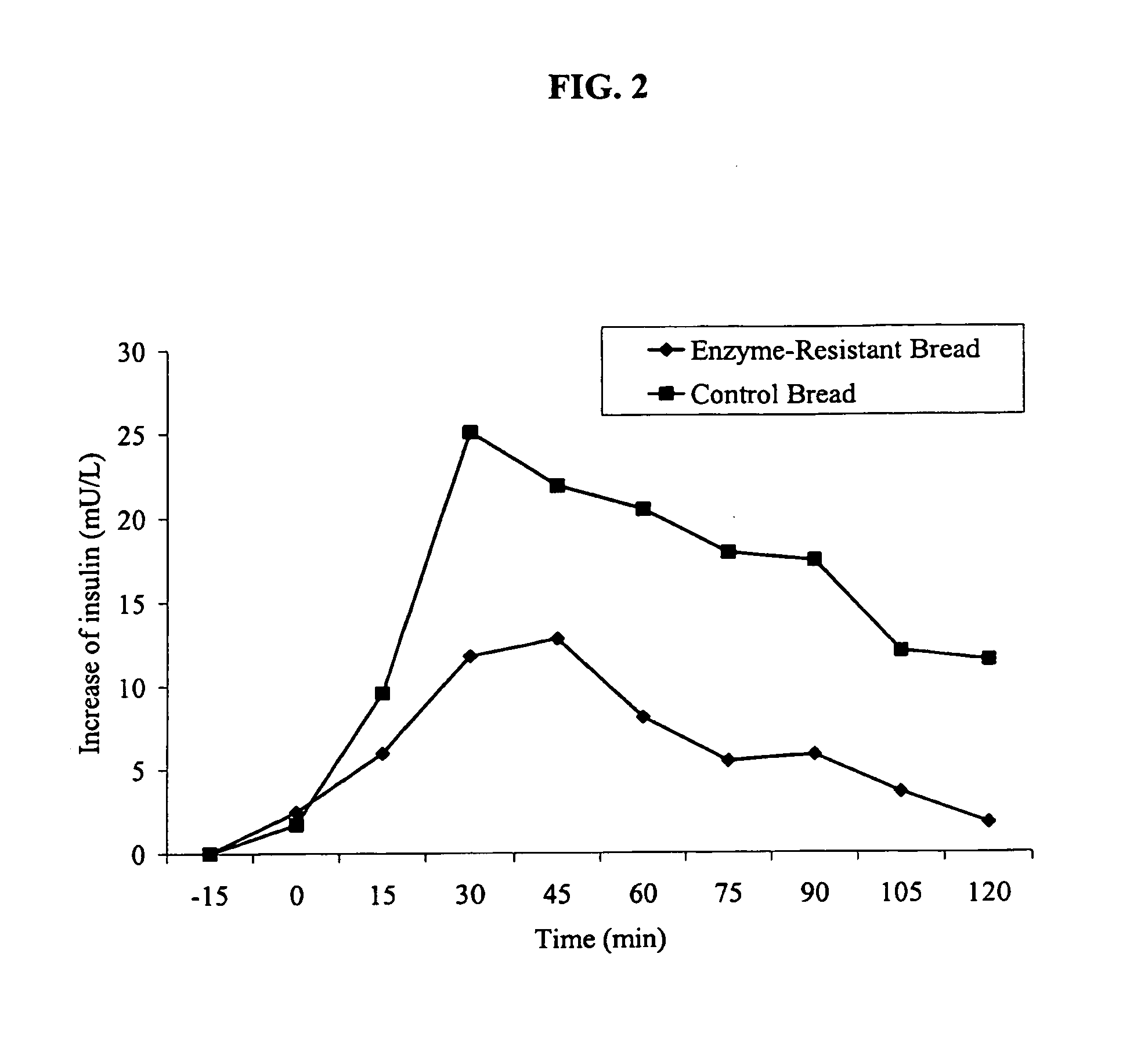Resistant food starches and methods related thereto
a technology of food starch and resistant starch, which is applied in the field of food ingredients, can solve the problems of high heat, high cost of starch, and energy-intensive commercial processing of resistant starch, and achieve the effect of less time- and energy-consuming
- Summary
- Abstract
- Description
- Claims
- Application Information
AI Technical Summary
Benefits of technology
Problems solved by technology
Method used
Image
Examples
example 1
Materials Useful to Make or Analyze Resistant Starch
[0032]The following materials were gathered for use in producing and testing resistant starch formulations and processes. High amylose cornstarch VII starch (HA7, AmyloGel™ 03003) and normal cornstarch (NC) were gifts of Cargill, Hammond, Ind. Lecithin (LE, Ultralec®-P), diglycerides (DG, Enova™), and monoglycerides (MG3, Panalite® 90-03 K; MG70, Panalite® 90-70 K; MG130, Panalite® 90-130 K; the number represents the iodine value or the degree of unsaturation of monoglycerides) were gifts of ADM, Decatur, Ill. The following enzymes and reagents were purchased from Sigma-Aldrich Corp. (St. Louis, Mo.) and used as received: sodium propionate (NaPr, Cat. No. P1880), butyric acid (BA, Cat. No. B2503), myristic acid (MA, Cat. No. M3253), palmitic acid (PA, Cat. No. P0625 and Cat. No. W283207), stearic acid (SA, Cat. No. W303518), oleic acid (OA, Cat. No. 364525), heat-stable α-amylase from Bacillus licheniformis (Cat. No. A3403), protea...
example 2
Methods Used to Analyze Resistant Starch Content and Protein Content of Food Samples Containing Resistant Starches
[0033]A. Enzymatic-Gravimetric Method (AOAC Method 991.43) for Determining Dietary Fiber (Resistant Starch) Content of a Sample.
[0034]A precisely weighed starch sample (1 g, dry starch basis, dsb) was suspended in a MES-Tris buffer solution (0.05M, pH 8.2, 40 mL). Heat-stable α-amylase (500U) was added to the suspension. The mixture was incubated in a boiling-water bath with stirring for 30 minutes. The enzyme digestate was then cooled and equilibrated in a water bath at 60° C. and incubated with protease (5.0 mg) at the same temperature for 30 minutes under agitation (120 rpm). The suspension was then adjusted to pH 4.4-4.6 by adding hydrochloric acid solution (0.561 M) and incubated with glucoamylase (300 μL) in the water bath at 60° C. for 30 minutes under agitation (120 rpm). The enzyme digestate was then cooled to room temperature and filtered through a tared coarse...
example 3
Preparing and Analyzing Novel Resistant Starches from HA7 and Fatty Acid—Heating at 80° C.
[0039]An aqueous suspension of AmyloGel™ 03003 (10% w / w) (“HA7”) was heated in a water bath at 80° C. for 30 minutes. Fatty acid (2-10% w / w, dsb) was added to the suspension with stirring. The starch-fatty acid mixture was heated in the water bath at 80° C. for additional 30 minutes. The mixture was then cooled to room temperature. The starch-fatty acid complex was recovered by centrifugation, washed with 50% ethanol, and dried in a convection oven at 50° C. to a moisture content of below 12% (w / w). The RS contents of the resulting products are shown in Table 1.
TABLE 1The resistant starch contents of Example 1.Treatments1Resistant starch2 (%)HA7 control36.7 ± 0.2HA7 + 10% PA58.3 ± 1.7HA7 + 10% SA59.8 ± 2.81HA7 = AmyloGel ™ 03003 (high amylose cornstarch VII), PA = palmitic acid, SA = stearic acid, and percentage = weight percentage of fatty acid, dsb.2Resistant starch content was analyzed using...
PUM
| Property | Measurement | Unit |
|---|---|---|
| Temperature | aaaaa | aaaaa |
| Temperature | aaaaa | aaaaa |
| Temperature | aaaaa | aaaaa |
Abstract
Description
Claims
Application Information
 Login to View More
Login to View More - R&D
- Intellectual Property
- Life Sciences
- Materials
- Tech Scout
- Unparalleled Data Quality
- Higher Quality Content
- 60% Fewer Hallucinations
Browse by: Latest US Patents, China's latest patents, Technical Efficacy Thesaurus, Application Domain, Technology Topic, Popular Technical Reports.
© 2025 PatSnap. All rights reserved.Legal|Privacy policy|Modern Slavery Act Transparency Statement|Sitemap|About US| Contact US: help@patsnap.com


